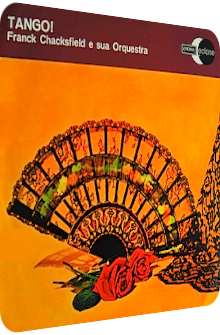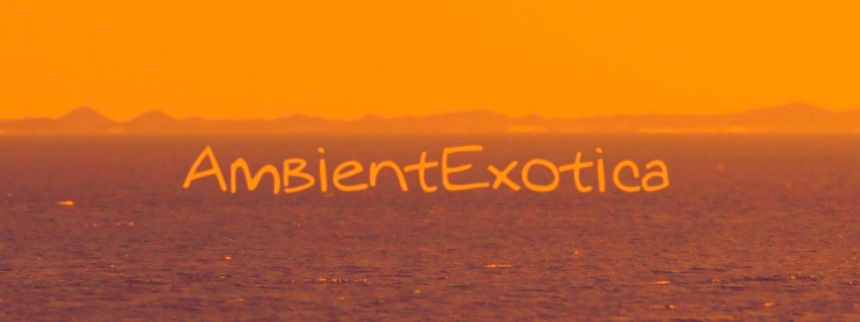
Frank Chacksfield
Tango!
1962
A title such as Tango! says it all, so why bother and write an in-depth review? Because it contains many a stylistic particularity that illuminates the darkest of all Latin styles. Conducted and arranged by Frank Chacksfield (1914–1995), released in 1962 on Decca’s sublabel Eclipse and comprising of 12 Tangos, two of them written by Chacksfield, with another duo being taken from famous movies, this album is the ultimate artifact for lovers of the genre… or rather not! Chacksfield does many things differently on this album, and while they would not be noteworthy in other contexts, they change the concept, style and tradition of the Tango, and more often than not for the better. Horns, strings and accordions make up the majority of this album, with softly shuffling cymbals and hi-hats providing the archetypical rhythm.
So far, so usual. But the strings! These strings are enchanting, but so are many other albums which thes appear in. It is the addition of their complexion to the Tango genre that makes this album work so well. The exclamation mark in the title might suggest a truly lovestoned and creepily romantic milestone or even blueprint, but this is decidedly not the case. Instead, Space-Age timbres waft into the shadiest Latin genre and bring a fresh breeze into the antediluvian scenery. Chacksfield refrains from adding too many schmaltzy or gimmicky tidbits into the arrangements, but there is enchantment to be found… and darkness, for shadowy instances remain a firm part after all.
Fluffy and aquiver with joy in the wake of a walk through the confectionery store, this could be the alternative scenario of Julio César Sanders’ Adios Muchachos once it is interpreted by Frank Chacksfield. His take could be the soundtrack to one of Audrey Hepburn’s many romantic flicks. The flutes reside in fairy forests, a way too warmhearted accordion takes all the besotted passion out of the Tango, making room for the mellow string washes to shine. Undoubtedly a candied piece, providing a different take on the dead-serious Tango tradition. Tonight is no different, and this time, the composition is based on a movie: West Side Story from 1957. Written by Leonard Bernstein, Chacksfield evokes a nocturnal aura via a softer haze of strings, helicoidal harp twangs and a leading enchantress who is accompanied by another dose of gorgeous string billows. The Tango rhythm is noticeable, yet faraway, as if watched through a rose-colored gauze.
While La Cumparsita by Enrique Pedro Maroni, Gerardo Hernán Matos Rodriguez and Pascual Contursi only ventures into well-known Exotica territory from the outset and otherwise proves to be the expected dark and passionate pizzicato performance somewhere in a Chilean cellar or Bolivian bodega, Allan Stuart’s and Paul Dupont’s La Rosita is the otherworldly counterpart and encapsulates a truthful Exotica spirit via phantasmagoric strings of the wayfaring kind, aqueous harp twangs which seem like waves and that carefree feeling of gazing onto paradisiac landscapes.
Midnight Tango follows, a piece written by David “Fathead” Newman and aural travelog aficionado Hugo Winterhalter, but it is – probably not so cleverly – awash with light, as string fountains, triangle sparklers, entangled harps and polyphonous accordion appendixes let the sunshine in, followed by side A’s finale The Song Of The Rose, written by Filippo Schreier and Aldo Bottero. Originally called Tango Delle Rose and part of some 1942 movie called Casablanca, Frank Chacksfield manages to oscillate between the partially doleful and preoccupied thoughts of a Tango participant and pours them into amicable brass moulds and sweet maple flutes. A dichotomous affair.
Side B opens with a euphonious Space-Age take: Hear My Song, Violetta by the quartet of writers Bob Emmerich, Buddy Bernier, Othmar Klose and Rudolph Luckesch is keen on the string side – business as usual – with all the sylphlike tone sequences as expected, but two parts make this a somewhat memorable take, at least amid the endemics of the LP: for one, a Baroque harp segue is sewn into the reticulation, and secondly there are wordless acatalepsies aplenty. There is even a timpani bang at the end, for what it’s worth. One of two unique pieces is presented next, Frank Chacksfield’s own cheekily called Tango De La Zarzuela, although it ought to be clear that the conductor and arranger has the art form of the musical comedy in mind, not the Spanish seafood dish of the same name. As such, hilarity should ensue, but does not manifest itself after all, as this piece is another unexpectedly serious effort with piercing brass stabs, dun-colored accordion coils and woodpecker marimba specks. Whatever rid Chacksfield to name this Tango in this peculiar way, its name is misguiding. Does that make it funny? I suppose so.
No Other Love, meanwhile, is a corker with aureoles and chromaticity to the maximum. Written by Oscar Hammerstein II and Richard Rodgers, this piece introduces a wondrously glacial and cavernous vibraphone undercurrent to the intrinsic pool of instruments, replaces the instrument with a clarinet in a different segue and rounds the long-winded interstices of with pink strings and aeriform movements of elation. Green Eyes aka Aquellos Ojos Verdes by Adolfo Utrera, Eddie Rivera and Eddie Woods is another pizzicato prongfest with sugar-sweet strings, washed out horn hedges and warmhearted accordion adjuvants, with Frank Chacksfield’s second tune Tango Romano serving as a foil to Yma Sumac’s Mambo! (1954) by means of its hugely cinematic brass blasts. These, however, are of the friendly and festive kind, and so this string-accentuated fanfare is dreamy, magical and prissy enough to not outshine Sumac’s most energetic album of the 50’s. The final tune is a rendition of Agustín Lara’s famous You Belong To My Heart aka Solamente Una Vez whose uplifting melody makes for a great Tango apotheosis. It gleams and is ablaze with colors, compatible with an Easy Listening and Exotica fan’s favorite timbre. Even though no bongo or weird instrument graces the arrangement, You Belong To My Heart shines in this version, too.
Tango! might be one of the most surprising, well, dedicated Tango albums that have ever been created, but neither have you read a sentence like this about it anywhere else nor will it be repeated in other places. This has probably to do with the fact that Tango! is not necessarily a great album per se, even if the respective listener is fond of Easy Listening, Exotica or Latin music. So why, then, do I make such a bold statement? Well, the surprise level is based on the diaphanous physiognomy and the lofty arrangements with their many delightful string formations. As I have previously stated in the opening paragraph, the Tango genre – tradition even – is one of the darkest hours of Latin music, or to be more precise: it is written for the darkest hours when the time is nigh(t) to dance with a loved one in front of a large audience that is eager to watch every little step. Even if the Tango is taken out of this competitive frame, it contains a murky core by design.
It is only two or three times on Frank Chacksfield’s LP where this core is brought to light… and this is the magic word alright: light. The wealth of aerose strings and the manifold antimatter instances of vibraphones, marimbas and backdrops full of triangles round off the already quasi-transcendental state of Tango! and most of its 12 tracks. The rare misstep such as the unique – of all things – Tango De La Zarzuela do not diminish the enjoyment overly much. Frank Chacksfield’s LP might be but one little dob in his huge discography; it might likewise be washed away by the flood of real Exotica releases and better known Space-Age artifacts, but it is one album to cherish for the transfiguration of the Tango alone. Tango! is available on LP and as a digital incarnation on Amazon MP3, iTunes and cohorts.
Exotica Review 330: Frank Chacksfield – Tango! (1962). Originally published on Apr. 5, 2014 at AmbientExotica.com.
